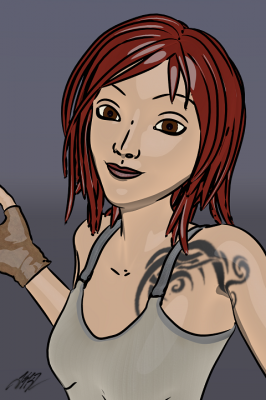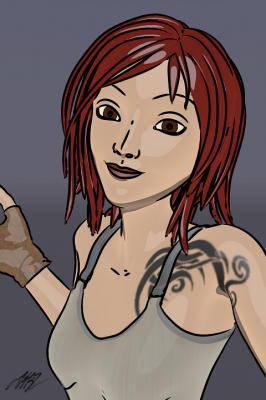Today I came across a news report about the status of “Freestyle” in Blender, which reminds me of the animation style issues I’ve been contemplating for Lunatics since the beginning: just how realistic will we want the graphic style of the series to be?
There are a lot of design challenges with Lunatics. One of these has been the character design, where we have to balance the need for realistic proportions to support interfacing with the very real “hard science fiction” sets and props with the expressive exaggeration needed for engaging animated characters. Also, to avoid the “uncanny valley” (where our characters start to look like lifeless dolls or zombies), we need for the movement of the characters to be as or more realistic than the drawing style.
Essentially, the drawing style sets your expectation for the level of filtering you unconsciously apply to what you see — if it’s very stylized, then you expect to filter a lot, and unnatural movement won’t bother you much. But if the style of drawing is very naturalistic, then you expect the movement to be so as well. If it is not, then you interpret the unnatural movement as the actually intended movement of the characters — leading to an impression that they are robots or zombies or something instead of humans. We’re very sensitive to movement in our perception of other people, and so it’s easy to screw this up and spoil the illusion. Audiences may tolerate that (plenty of 3D game characters fall into the uncanny valley, for example), but we’d lose some.
Add to that that our budget for animation is tiny (it’s undecided just how tiny), and we are planning to do things like “digital puppetry” or “machinima” to keep it within our scope, and it’s very possible that we could get disappointing results.
If we use a less realistic style, however, the audience will be more forgiving of the animation. And exaggeration of features is not the only way to achieve that. Another method is to alter the drawing or “rendering” style of the characters. At the extreme, they can be made to look very much like 2D-animated cartoon characters. This has been done successfully on major productions, such as “Futurama” (which also uses feature exaggeration, of course, but here I’m focusing on the fact that what appears to be 2D animation is sometimes being done in 3D and “toon-rendered”).
Another good example is the “Ghost in the Shell: Standalone Complex” anime series, which makes extensive use of this kind of rendering.
Following a trend in Japanese animation, I want to make use of the so-called “masking effect” in which backgrounds are rendered more realistically than the foreground characters (e.g. in traditional cel animation anime, the backgrounds were often watercolor paintings, while the foregrounds were line drawings on cels with limited-palette coloring — digital cel animation in anime often mimics this appearance even today, although more complicated mix-ups are possible now). Similarly, for Lunatics, I’d like to retain subtle shading in backgrounds, though I may want to render foreground characters in a more simplified way (keeping them more similar in appearance to the model sheet and concept art that we’ve been developing). Ideally, I’d have some kind of “realism slider” and be able to tweak it back and forth to find just the right “sweet spot” for our production (I suspect it’ll be a bit more work than that).
Rendering foregrounds and backgrounds differently is not really that hard in terms of workflow — even when the same type of rendering is being done, it’s not uncommon to render elements separately and then composite in 2D. This can allow for tweaking angles or lighting for dramatic effect. So, adding a different renderer or changing rendering settings would not be very disruptive.
In the Blender ecosystem, the tool that allows for this kind of “non-photorealistic rendering” is “Freestyle“. So it was interesting to see this April 2nd update, which includes some example freestyle renderings.
An even better example, though, is this “freestyle rendering of Sintel“, which is derived from the title character in the “Sintel” open movie. Considering that the model was designed for normal, photo-realistic rendering, I find this example particularly compelling.
Another advantage of freestyle 3D rendering like this is that it can integrate better with actual 2D animation, such as can be done with Synfig Studio.
A colleague, Konstantin Dmitriev, who is a Synfig developer and 2D animator (see “Morevna Project“), has offered the possibility of contributing 2D animation on contract to Lunatics, and he does have a track record of doing commercial 2D animation. It’s an interesting idea. A few very well placed pieces of 2D animation might indeed improve on an otherwise toon-rendered 3D project.
I probably won’t come to a final decision on this until I have the chance to do some test renders each way, but it’s certainly something I’ll be thinking about during the production process.
[Retired link “http://www.themedianinja.com/glenn/legacy/default_links/anime_links/mccloud.html”]


